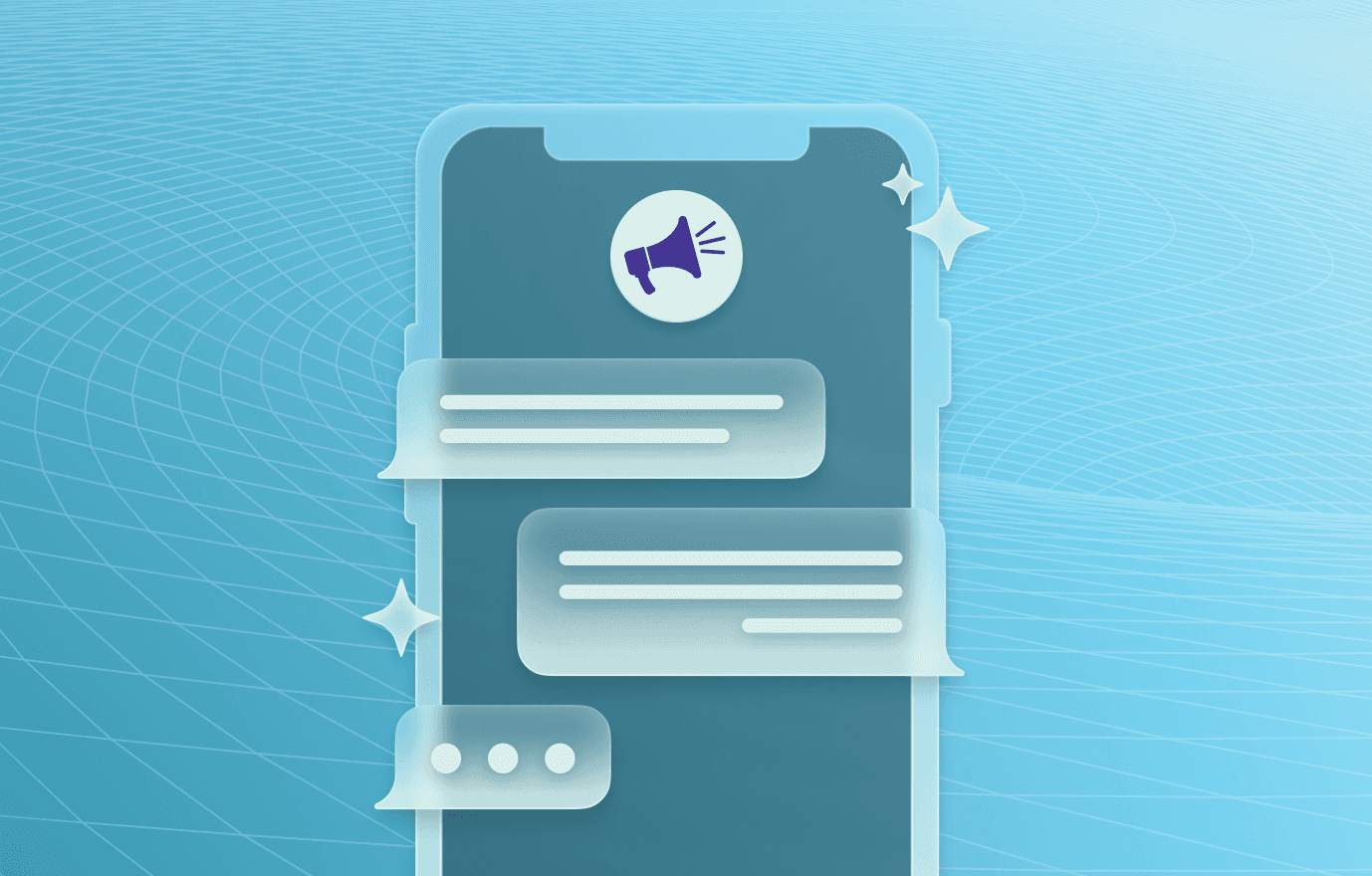Chatbot /
15 Min read
Conversational Marketing – A Comprehensive Guide
November 19, 2024
Hardik Makadia
Co-founder & CEO, WotNot
Imagine having a conversation with a brand just like you would with a friend—quick, easy, and personal. That’s the magic of conversational marketing!
It’s all about creating real-time, one-on-one connections through tools like chatbots, live chat, and messaging apps. But you might wonder, what is conversational marketing exactly, and why is everyone talking about it?
Well, that is why we have created this guide in which we’ll cover everything from the basics of conversational marketing to its benefits, strategies, and some real-world examples. Whether you’re curious about how conversational marketing works or want to explore the best platforms, you’ll find all the insights you need here.
Let’s dive right into it!
What is Conversational Marketing?
Put simply, it’s a way for brands to build strong relationships with customers through natural, two-way conversations. Unlike traditional marketing, which often feels one-sided, conversational marketing invites customers to engage directly through conversational marketing software—getting instant answers and personal responses.
Conversational marketing channels, such as messaging apps and chat windows, facilitate personalized and seamless interactions.
It’s all about breaking down barriers and making digital interactions feel more human. At its heart, conversational marketing is all about meeting people where they are, building trust, and turning casual conversations into meaningful relationships.
Why Conversational Marketing Strategy Matters
With the increase in conversational tactics, businesses are now shifting their interactions with customers into a digital space, where it’s crucial to provide meaningful conversations on the channels where people are already engaging. Understanding the buyer journey is crucial for personalizing customer experiences, as it allows businesses to address consumer needs at every stage of the buying process.
A strong conversational marketing strategy empowers brands to provide fast, personalized messages for common customer inquiries—whether it’s answering FAQs, booking appointments, addressing pain points, or gathering feedback.
Personalized interactions through chatbots can enhance the experience at every stage of the customer journey.
Unlike traditional marketing, which often relies on broad strategies like cold calling or print advertising, conversational marketing focuses on individual needs and preferences. Traditional tactics can be hit-or-miss, often wasting resources on prospects who may not be interested in your product/service.
In contrast, conversational marketing engages customers who show genuine interest, creating better experiences tailored to them. By utilizing conversational AI and data insights, brands can learn about customer behaviors and preferences, allowing them to deliver targeted messages that convert. This not only enhances customer satisfaction but also equips sales teams with more qualified leads, making every interaction more valuable and fostering two-way communication that leads to increased customer loyalty.
What are the benefits of conversational marketing?
With the shift toward real-time communication, a successful conversational marketing strategy can boost customer satisfaction, improve conversion rates, and create genuine brand loyalty.
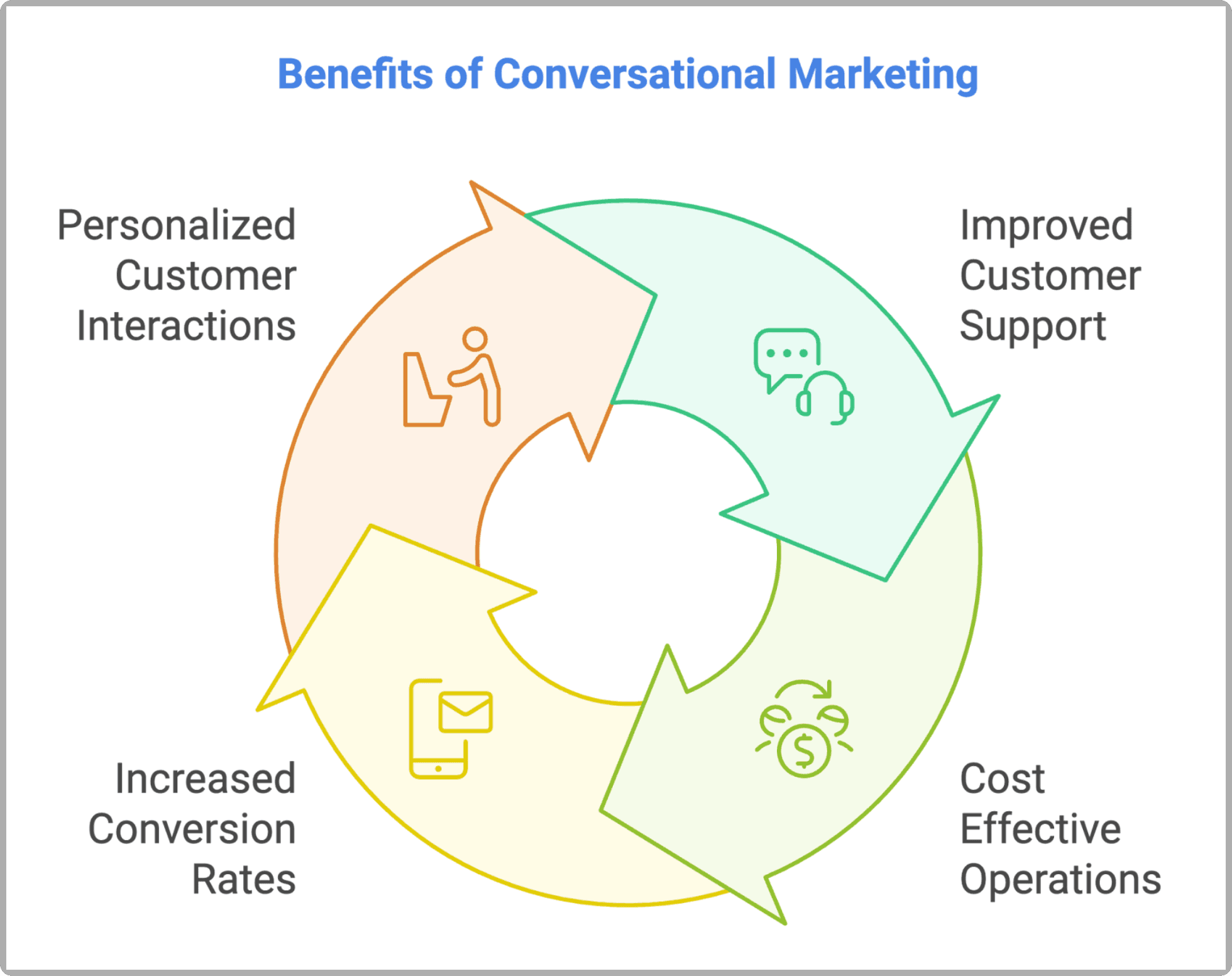
Here are some key benefits that conversational marketing can bring:
Personalized Customer Interactions: Today’s customers expect brands to understand their needs and respond personally. A conversational marketing platform, powered by AI, can provide personalized answers and recommendations, guiding users seamlessly through their journey. This level of engagement helps businesses to build relationships that keeps customers coming back. Additionally, it enhances the customer experience across the entire customer journey, from initial contact to post-sale support. To support these efforts in the eCommerce space, investing in high-performance magento 2 hosting ensures fast, reliable, and secure customer interactions.
Improved Customer Support: A conversational marketing bot can tackle routine questions around-the-clock, like answering users queries or sharing product information. By handling these common inquiries, bots reduce wait times and ensure human agents focus on complex issues, providing faster, higher-quality service. It’s a win-win for both customers and customer support teams. Chatbots also enable brands to collect valuable data through two-way chats, which is crucial for making tailored recommendations and improving future marketing campaigns.
Cost-Effective Operations: Implementing a conversational marketing strategy often reduces operational costs. With AI chatbots, businesses can handle multiple inquiries across channels without adding to team overhead, resulting in streamlining customer support processes, saving time, and allocating resources more strategically without compromising on service quality.
Higher Engagement and Conversions: Conversational marketing examples show that interactive, real-time conversations naturally increase customer engagement. Whether it’s a chatbot suggesting relevant products or scheduling meetings, these interactions often result in higher conversions and drive a better customer experience overall.
Streamlined Sales Cycle: When potential customers have instant access to answers, their buying decisions are quicker and more confident. A conversational marketing bot can qualify leads instantly, passing them on to sales team without delay. This approach helps businesses shorten the sales cycle while building trust throughout each stage.
Better Data Insights: Conversational marketing isn’t just about interactions; it’s about learning from them. Each conversation provides insights into customer preferences, frequently asked questions, and product interests. Over time, this data helps refine a brand’s approach, making every interaction smarter and more relevant. This approach supports customer needs throughout the entire customer lifecycle, from initial contact through to post-purchase.
How does conversational marketing work?
Conversational marketing works by focusing on identifying customer needs and providing tailored solutions, typically through tools like chatbots, messaging apps, and live chat. The goal is to engage customers in authentic, conversational interactions on the platforms they already use. Conversational marketing sounds different from traditional marketing strategies because it encompasses unique elements that set it apart from standard practices.

Here’s a closer look at how it works:
Understanding Customer Intent: The first step in any effective conversational marketing strategy is understanding what customers are looking for. With tools like WotNot, a conversational marketing platform, businesses can analyze customer questions, detect their intent, and respond accordingly. Whether someone is looking for services, looking for pricing details, or looking for support, the platform tailors responses to match their needs.
Instant Responses with Chatbots and Live Agents: One of the key benefits of conversational marketing is the speed of response. Conversational marketing bots can provide instant answers to common questions and guide customers through quick actions, like checking pricing or asking questions regarding a product. For more complex needs, the bot can smoothly initiate a human handover, connecting the customer with a live agent, ensuring no question goes unanswered.
Personalizing the Experience: Unlike traditional marketing, conversational marketing platforms can personalize responses based on each user’s history, preferences, and previous interactions. For example, if a customer frequently asks about specific product categories, the chatbot might recommend similar items or share tailored promotions. In the era of short-form media, this can also extend to sharing dynamic vertical video content that captures attention and delivers information more effectively. This personalized approach builds engagement and shows customers that the brand understands their unique interests.
Gathering and Using Data: Each interaction gives brands insights into customer preferences and behavior. Conversational marketing platforms track these interactions, providing valuable data on popular products, frequently asked questions, and typical pain points. This data doesn’t just help improve conversations—it also helps brands refine marketing strategies, develop new products, and improve the overall customer experience.
Supporting Multiple Channels: Conversational marketing isn’t limited to a single channel. Whether customers are on social media, the brand’s website, or a messaging app, conversational marketing tools can engage with them across various touchpoints. This ensures that customers receive consistent, personalized experiences no matter where they reach out.
Enhancing Inbound Marketing Strategy: Conversational marketing is a crucial component of an effective inbound marketing strategy. It enables businesses to engage customers through personalized interactions, thereby enhancing the overall customer experience. This approach highlights the importance of seamless communication channels and meaningful conversations throughout the customer lifecycle.
Some examples of Conversational Marketing strategy
Conversational marketing is all about creating engaging, real-time interactions that feel personal and relevant. Here are some compelling examples of how brands are successfully implementing conversational marketing strategies across various platforms:
Lead Generation and Qualification
Engage website visitors with real-time conversations to capture and qualify leads effectively. Use AI-driven chatbots or live chat to ask targeted questions, ensuring only high-quality leads reach your sales team.

Example: A SaaS company uses a chatbot to greet website visitors and ask about their business size, needs, and budget. Based on responses, the chatbot either books a demo with a sales rep or directs the user to resources for further exploration. This saves time for the sales team and improves conversion rates.
Personalized Product Recommendations
Deliver tailored product suggestions based on customer preferences, browsing history, or past purchases. Enhance customer experience and drive sales by offering relevant choices in real-time.
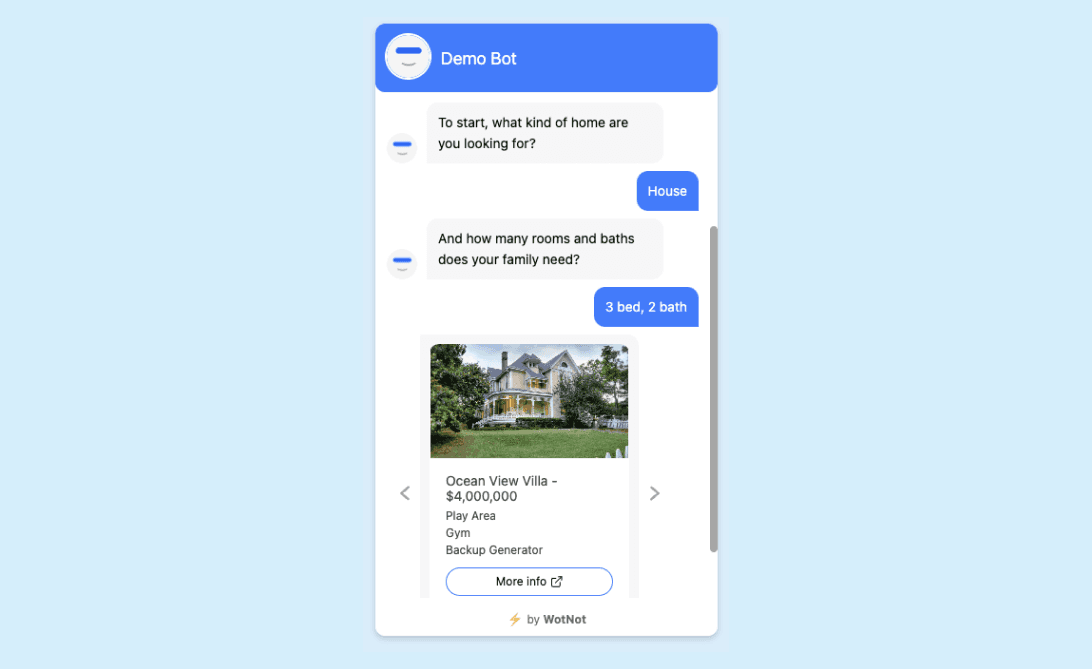
Example: An e-commerce platform tracks user preferences through previous interactions and uses a chatbot to recommend items during sales events. For instance, a customer browsing sneakers might receive a chatbot message suggesting matching socks or running accessories, leading to an increase in the average order value.
Customer Support and Retention
Provide instant customer support to resolve queries, improve satisfaction, and foster loyalty. AI-driven conversational tools handle FAQs, troubleshoot problems, and escalate complex issues.
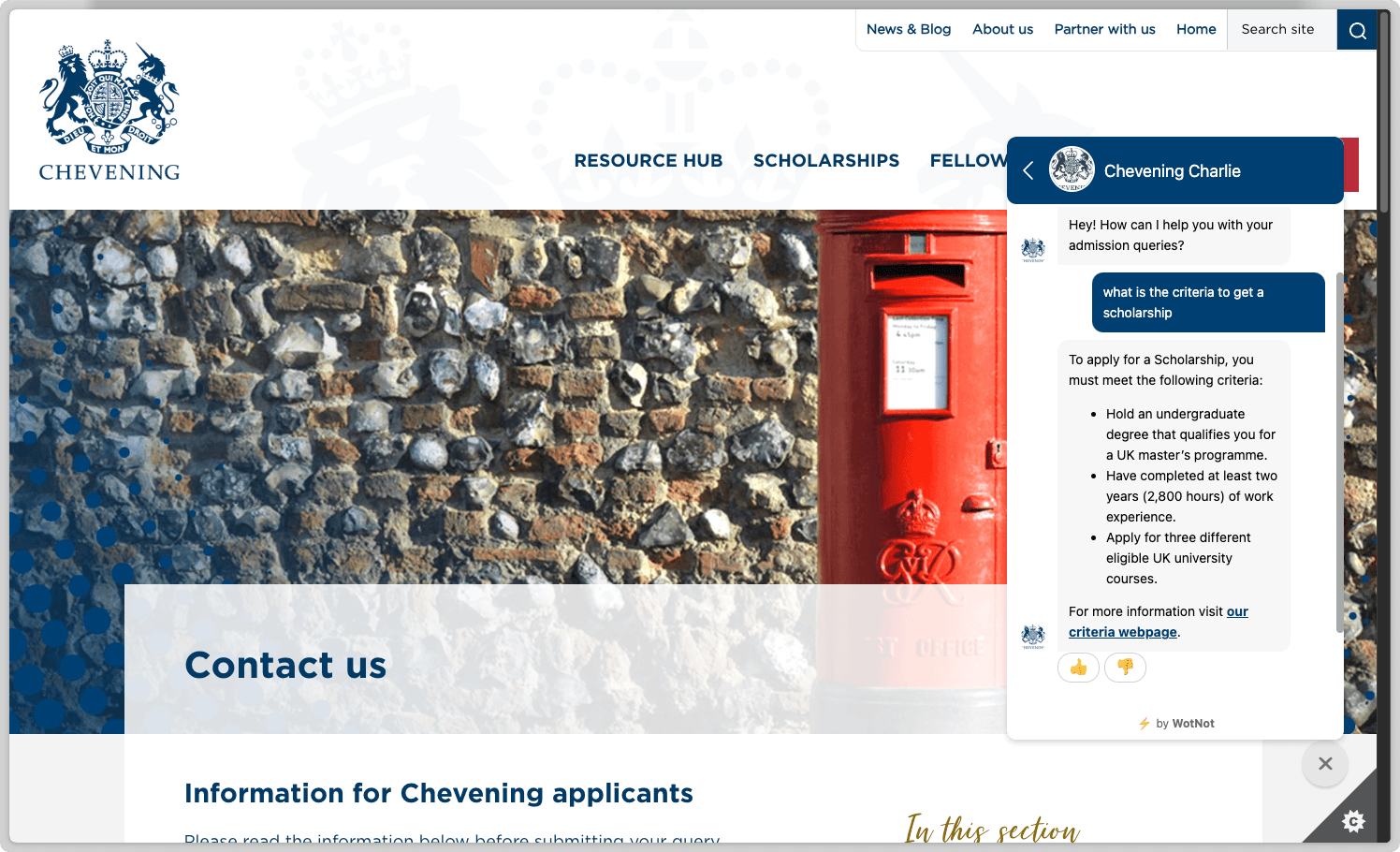
Example: A telecom company integrates chatbots into its support channels. Customers asking about slow internet receive troubleshooting tips directly in chat, while billing inquiries are seamlessly escalated to human agents when necessary. This hybrid support model ensures faster resolutions and higher retention.
Event Registration and Reminders
Simplify event registration and attendee management with conversational tools. An effective event management software combined with AI chatbots can provide instant responses to FAQs, confirm registrations, and send timely reminders to boost attendance.

Example: An event organizer integrates a chatbot into its website to assist visitors with registration. The bot collects participant details, confirms attendance, and sends reminders a day before the event. Attendees also use the bot for event-related queries, improving the overall experience.
Brand engagement
Encourage your audience to connect with your brand ahead of an upcoming event. Leverage a chatbot to interact with users, share brand information, and gather valuable audience details.

Example: A fashion retailer opening a new store in a mall uses a Facebook Messenger chatbot to boost event participation. The chatbot engages users with fun brand-related questions and enrolls them in a lucky draw. To claim their prize, users must attend the store launch, driving footfall and excitement.
With elearning content software, businesses can create platforms to educate their audience on the brand, its products, and the story behind it, resulting in more customer understanding and meaningful connections.
Upselling and Cross-Selling
Leverage conversational marketing to suggest premium or complementary products. Drive higher revenue by recommending upgrades or add-ons based on customer behavior.
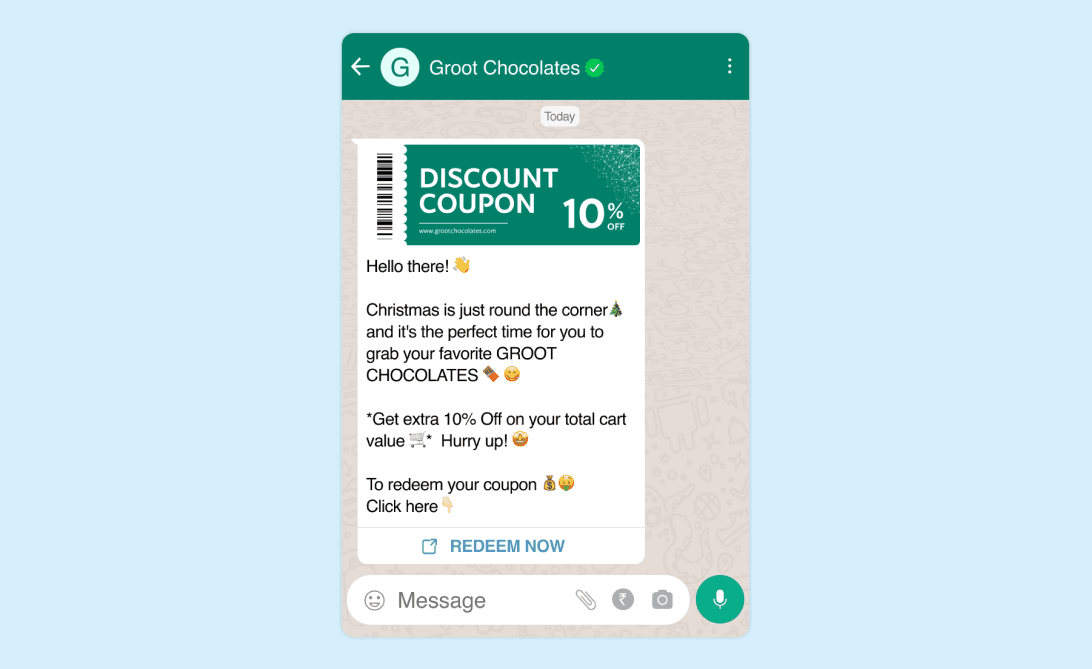
Example: A streaming service uses AI chatbots to engage subscribers during plan renewals. The bot highlights benefits of upgrading to premium plans, such as exclusive content, or suggests add-ons like offline downloads. These personalized recommendations increase average revenue per user.
Booking Appointments or Reservations
Streamline appointment or reservation processes with conversational marketing. Allow customers to book, reschedule, or cancel via chat, reducing manual efforts.
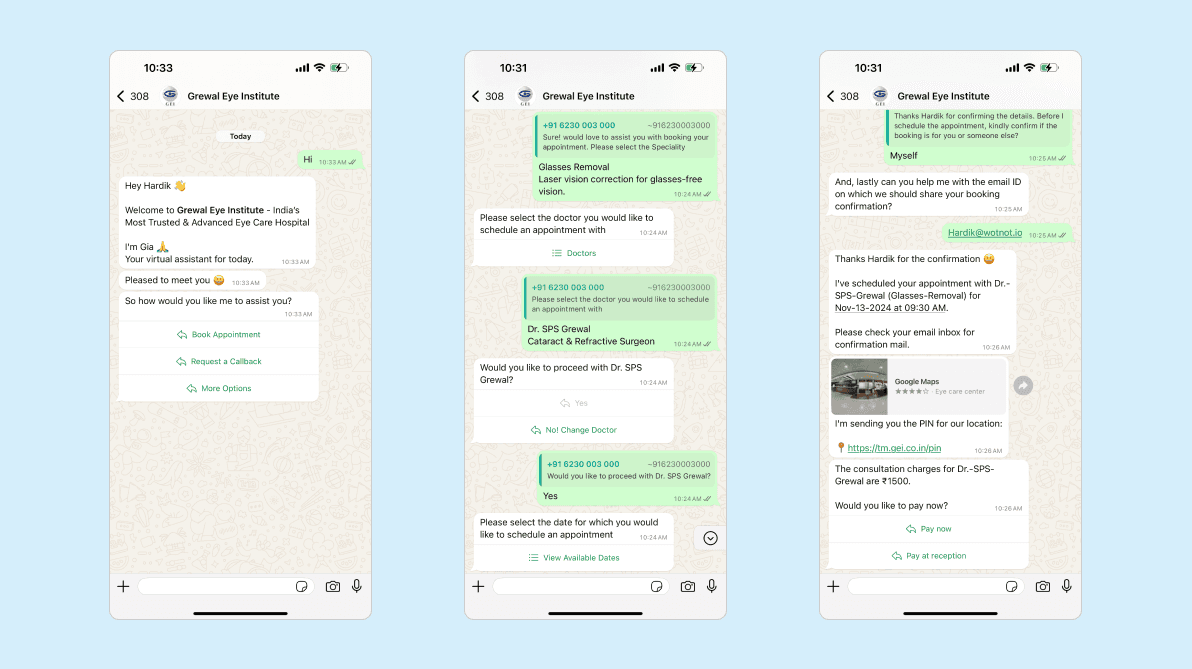
Feedback Collection and Surveys
Use conversational tools to collect actionable feedback from customers in a seamless manner. Interactive chatbots make surveys engaging and improve response rates.

Example: A restaurant chain uses a chatbot to ask diners about their experience right after a meal. Customers rate food, service, and ambiance through an intuitive chat interface. Negative feedback is flagged for immediate action, while positive reviews are encouraged to be shared online, enhancing the brand’s reputation.
These examples illustrate the versatility and effectiveness of conversational marketing in various industries. By encouraging genuine interactions, brands can build stronger relationships with their customers, enhance their overall experience, and ultimately drive sales. A marketing team can utilize analytics from social media platforms to better understand audience preferences and improve engagement, thereby driving effective marketing initiatives.
Conclusion
Conversational marketing isn’t just a trend—it’s a shift toward creating genuine, meaningful interactions with customers. By adapting this approach, brands can respond faster, offer more personalized support, and build trust in a way that traditional marketing just can’t match. With the right tools, like WotNot, businesses can seamlessly guide customers, improve support, and gain insights that make every interaction count.
If you’re ready to explore how conversational marketing can bring your business closer to your customers, consider signing up or scheduling a demo to see its impact firsthand.
ABOUT AUTHOR
Hardik Makadia
Co-founder & CEO, WotNot
Hardik leads the company with a focus on sales, innovation, and customer-centric solutions. Passionate about problem-solving, he drives business growth by delivering impactful and scalable solutions for clients.
